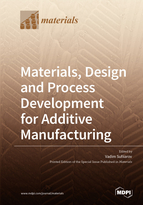Materials, Design and Process Development for Additive Manufacturing
A special issue of Materials (ISSN 1996-1944). This special issue belongs to the section "Manufacturing Processes and Systems".
Deadline for manuscript submissions: closed (28 February 2022) | Viewed by 37522
Special Issue Editor
Special Issue Information
Dear Colleagues,
Additive manufacturing is already actively used in various high-tech industries today. At the same time, there is a certain limitation and imperfection of known and widely used conventional materials when they are used in additive manufacturing.
In this regard, extensive research and development are aimed at the advancements of new materials by adjusting the chemical compositions of conventional alloys, new equipment with expanded functionality and the ability to work with a wide range of materials that were previously not available for additive manufacturing.
This issue will cover a wide scope of additive manufacturing processes, comprising investigation, characterization of materials and their properties, development and application of new materials, structures designed for additive manufacturing, as well as processes and techniques that will expand the potential applications of layer-by-layer synthesis.
Topics of particular interest include but are not limited to:
- New biomaterials, including alloys with reduced Young modulus, and porous and biodegradable alloys;
- New material formulations and composite materials adapted specially for additive manufacturing;
- High-entropy alloys, ceramics, metal- and ceramic-matrix composites;
- Metamaterials and alloys with shape memory effect;
- Bulk metallic glasses and nanocrystalline alloys;
- Difficult-to-weld materials (intermetallics, high carbon steels, etc.);
- Processing of materials by additive manufacturing and for application in additive manufacturing (powder, wire, composites, slurry, filaments, etc.);
- Multimaterial additive manufacturing;
- Materials with graded properties such as microstructure, chemical composition, density, etc.;
- Wire, filament, and slurry based additive manufacturing;
- In situ synthesis and adjusting alloying with blending powders;
- Characterization and performance of additively manufactured materials—mechanical, electrical, chemical, biological, etc.;
- Computer methods for designing alloys, structures, and simulation of processes.
It is my pleasure to invite you to submit a manuscript for this Special Issue. Full papers, communications, and reviews are all welcome.
Dr. Vadim Sufiiarov
Guest Editor
Manuscript Submission Information
Manuscripts should be submitted online at www.mdpi.com by registering and logging in to this website. Once you are registered, click here to go to the submission form. Manuscripts can be submitted until the deadline. All submissions that pass pre-check are peer-reviewed. Accepted papers will be published continuously in the journal (as soon as accepted) and will be listed together on the special issue website. Research articles, review articles as well as short communications are invited. For planned papers, a title and short abstract (about 100 words) can be sent to the Editorial Office for announcement on this website.
Submitted manuscripts should not have been published previously, nor be under consideration for publication elsewhere (except conference proceedings papers). All manuscripts are thoroughly refereed through a single-blind peer-review process. A guide for authors and other relevant information for submission of manuscripts is available on the Instructions for Authors page. Materials is an international peer-reviewed open access semimonthly journal published by MDPI.
Please visit the Instructions for Authors page before submitting a manuscript. The Article Processing Charge (APC) for publication in this open access journal is 2600 CHF (Swiss Francs). Submitted papers should be well formatted and use good English. Authors may use MDPI's English editing service prior to publication or during author revisions.
Keywords
- additive manufacturing
- microstructure
- properties
- alloys development
- 3D printing
- synthesis
- computer modeling







